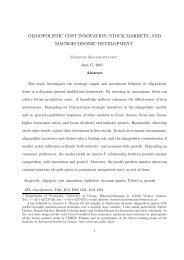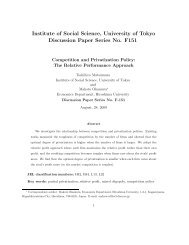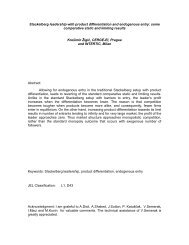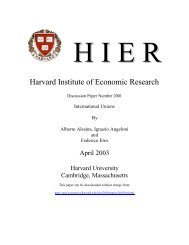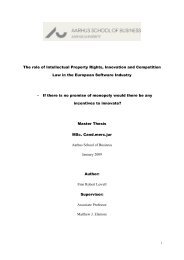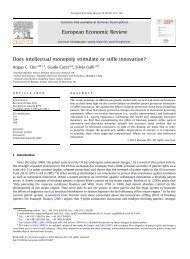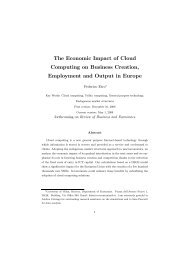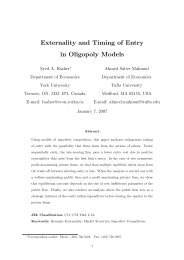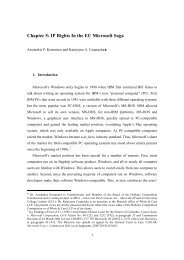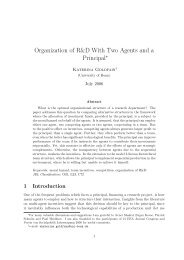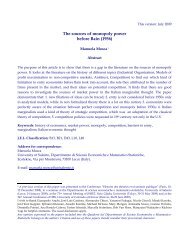The EU Approach to Abuse of Dominance - Intertic
The EU Approach to Abuse of Dominance - Intertic
The EU Approach to Abuse of Dominance - Intertic
You also want an ePaper? Increase the reach of your titles
YUMPU automatically turns print PDFs into web optimized ePapers that Google loves.
Summarizing the past economic research in the field, Tirole (2005) 21 has pointed out that the impact <strong>of</strong><br />
tying on competition in the tied market ranges from a negligible impact on the rivals’ ability <strong>to</strong> compete<br />
<strong>to</strong> entry deterrence, depending on a number <strong>of</strong> fac<strong>to</strong>rs like “the marginal cost <strong>of</strong> manufacturing the tied<br />
product; the rivals’ ability <strong>to</strong> differentiate horizontally or vertically their <strong>of</strong>fering from the tied product<br />
(that is, <strong>to</strong> <strong>of</strong>fer some features that are not available in the tied product); and, if the market is multi-sided,<br />
the ability <strong>to</strong> differentiate, in the side where there is no tie, through technological features, in-house<br />
supply, or exclusive contracts with third-party vendors, and the ease with which users on the tying side<br />
can multi-home.” According <strong>to</strong> Tirole, and we agree on this, tying should be submitted <strong>to</strong> a rule-<strong>of</strong>reason<br />
standard, since it can have both efficiency and anti-competitive purposes.<br />
<strong>The</strong> theory <strong>of</strong> market leaders (Etro, 2006) emphasizes that bundling by the incumbent 1) is just<br />
an aggressive (pro-competitive) strategy <strong>of</strong> the incumbent for a competitive tied product market, 2) may<br />
not have a specific entry deterrence purpose, and 3) may increase welfare even without taking efficiency<br />
reasons in<strong>to</strong> account.<br />
To derive these results, let us adopt the strongest bias against the bundling firm, imagining that<br />
this is a monopolist in a primary market with the possibility <strong>to</strong> enter in a secondary market, and that<br />
there are no clear technological efficiencies <strong>to</strong> obtain by bundling goods in the two markets. <strong>The</strong> Chicago<br />
school has studied such a situation when the secondary market is perfectly competitive, that is firms price<br />
at marginal cost and earn no extra pr<strong>of</strong>its: in such a case, the monopolist has no incentives <strong>to</strong> bundle<br />
because this could only reduce demand in the primary market. <strong>The</strong> post-Chicago approach has studied<br />
the same situation when the secondary market is not perfectly competitive and there is actually one single<br />
firm active strategically and no possibility for other firms <strong>to</strong> enter: then the only reason why the<br />
monopolist would like <strong>to</strong> adopt a bundling strategy is <strong>to</strong> induce exit <strong>of</strong> the rival in the secondary market<br />
(Whins<strong>to</strong>n, 1990). Finally, the new theory <strong>of</strong> market leaders has studied again the same situation but with<br />
a secondary market where firms decide “endogenously” whether <strong>to</strong> enter or not. In this case, the purpose<br />
<strong>of</strong> bundling has nothing <strong>to</strong> do with entry deterrence, it is just an aggressive strategy (but not a preda<strong>to</strong>ry<br />
one) which has pro-competitive effects: it reduces the combined price level and increases welfare.<br />
Technically, the market leader can exploit a larger scale <strong>of</strong> production for the bundle <strong>to</strong> <strong>of</strong>fer it at a<br />
competitive price: bundling the two products works as a commitment device <strong>to</strong> be aggressive, that is <strong>to</strong><br />
produce more for the secondary market and hence <strong>to</strong> be able <strong>to</strong> adopt a lower price. As a consequence,<br />
the leader can exploit larger scale economies, reduce the average price level for the consumers and hence<br />
increase welfare (Etro, 2006).<br />
Summarizing, while approaching a bundling case we need <strong>to</strong> verify the entry conditions <strong>of</strong> the<br />
secondary market. If there is a dominant firm in this market as well, the main problem is not the<br />
bundling strategy, but the lack <strong>of</strong> competition in the secondary market, and it should be addressed within<br />
21 See Jean Tirole (2005, “<strong>The</strong> Analysis <strong>of</strong> Tying Cases: A Primer”, mimeo, University <strong>of</strong> Toulouse, 2005).<br />
17



